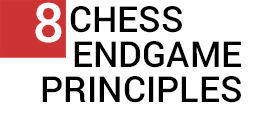The following chess endgame principles infographic, illustrates the 8 most important things you need to think about when playing an endgame.

Based on 12 Chess Endgame Principles
Tag: Endgame
-

8 Chess Endgame Principles
-
The Philidor Position
The Lucena and Philidor positions are the most important positions to know when it comes to rook and pawn endings. Here we will be looking at the Philidor position, which allows Black to draw against an opponent that is up a pawn. It’s important to note that the Philidor position only works if the opponent’s pawn has not reached the 6th rank.
1…Rb6 This move keeps that White King off the 6th rank. [2.Rg7 Ra6 3.Rg6 Rxg6 Heading into a drawn King and pawn endgame. 4.Kxg6 Ke7 ] The Black rook heads to the first rank, to begin checking the White King. With the White pawn having been pushed, White does not have any cover from the upcoming Black rook checks.
2.e6
3.Kf6 Rf1+ 4.Ke5 Re1+ 5.Kd6 Rd1+ =
-
Five Preliminary Endgame Rules
1. Before even beginning to think of making a passed pawn, put all your pieces into as good positions as possible.
Queen – Center of board
Rooks – seventh rank for White, second rank for Black. But if the enemy has two or more minor pieces the rook must be careful about leaving his own camp and must be content with commanding the open file.
Knights – Square in the center or in the enemy camp, supported by a pawn which is cannot be attacked by a pawn.
Bishops – Center diagonals; pawn support is not essential but desirable.
King – Central, provided that he is not dangerously exposed. If the enemy has a rook, the King is best posted at or adjacent to e2(e7) or d2(d7) – fairly near the center, but still preventing the enemy rook from seizing the second (seventh) or first (eight) rank.
2. Avoid pawn-moves while you are getting your pieces well positioned because pawn-moves create lasting weaknesses and thus make your task harder.
3. Try to free your position from weaknesses; and if possible, make it hard for the opponent to do likewise.
4. When trying to win, keep pawns on both wings. When trying to draw, play to eliminate all the pawns on one wing. With pawns on one wing only, a pawn plus is usually insufficient for a win.
5. If you are a pawn up or more, exchange pieces (not pawns) wherever you can do so without losing in position.
Exception: do not rush an exchange that will leave you with a single bishop running on the opposite color to the enemy’s single bishop. Also, refrain from exchanging if it will give your opponent two bishops against bishop and knight.
CJS Purdy
-
Training Position #1
White wins this position by creating a passed pawn on the Kingside.
Note that if the Black pawn would be on d3 instead of c3, the game would be a theoretical draw.
Copy the FEN position 4k3/1pp2ppp/p1p5/8/4P3/8/PPP2PPP/4K3 w – – 0 0 and play this position against an engine.
NOTE: There was an issue with the original post. There was a missing White pawn on d4. The diagram and the FEN diagram have been updated.
-
Endgame Positions
I have added a JavaScript replay chess board which contains critical endgame positions. Right now it contains three positions mainly King and pawn endgames dealing with the opposition, but I plan on adding more every couple of days.
-
Endgame Problem
Here’s the first of many endgame and middlegame problems to come:
King and pawn endgame problem -
Lucena Position
 Silman calls the Lucena Position “The Holy Grail of Rook Endings”. In this position Regardless of who’s turn it is to move, White wins.
Silman calls the Lucena Position “The Holy Grail of Rook Endings”. In this position Regardless of who’s turn it is to move, White wins.1.Rf2+ Forcing Black’s King to leave the scene of the battle.
1…Kg7 [1…Kg6 2.Rf4 Kg5 3.Rd4 Kf6 4.Ke8 Re1+ 5.Kf8 Rf1 6.d8Q+ Ke5+ 7.Ke7 ]
2.Rf4 Building a bridge.
2…Kg6 3.Ke7 Only now should White leave the cover of his pawn. Since promotion is threatened Black must go into checking mode.
3…Re1+ 4.Kd6 Rd1+ 5.Ke6 Re1+ 6.Kd5 Rd1+ 7.Rd4 Rxd4+ 8.Kxd4 Kf6 9.d8Q+ 1-0
-
King and Pawn Endgame with Pawns on Both Wings
The following endgame example illustrates how to turn a one pawn advantage into a win:
The conversion of an extra pawn falls into three phases: 1) the King is activated. 1.Kf1

1…Ke7 2.Ke2 Kd6 3.Kd3 Kd5 2)Mobilization of the majority. 4.b4

Mobilize by moving the “candidate”, which is the unopposed pawn.4…Kc6 5.Kc4 h5 6.a4 h4 7.b5+ Kb6 8.Kb4 g5 9.a5+

9…Kb7 10.Kc5 Kc7 11.b6+ axb6+ 12.axb6+ Kb7

3) The King goes to the Kingside to gobble up the Black pawns (transformation of one advantage to another):13.Kd6 Kxb6 14.Ke7 f5 15.Kf6+- .


